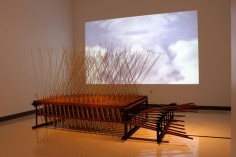JOHN POWERS
ДЖОНА ПАУЭРСА
ialu
source: ibtimes
The show’s curator, Laura Knott, describes John Douglas Powers’ large-scale piece “Ialu” as a temple-like experience.
“My interest in time-based works grew initially out of a natural desire to tinker and understand how things work,” Powers says. “Over the past decade or so, this has developed into an ongoing exploration of motion-based work that challenges the viewer’s own temporal existence.”
Powers says he’s particularly intrigued by the possibilities in artworks that a viewer has to follow in real time.
The pieces that make up Powers’ “Ialu” are part of an ongoing project exploring ancient Egyptian and Greek mythologies of the afterlife, filtered through the lens of a rural U.S. landscape, he says. Each unit of “Ialu” — made from wood, steel, and plastic, powered by an electric motor — takes about a month or two to complete, Powers says.
“The building process begins with a certain amount of trial and error by ‘sketching’ three dimensionally with the materials to determine proportions and dimension,” Powers explains. “The components of the mechanism are then designed using [computer design] software and lasercut prior to fabricatio.
.
.
.
.
.
.
.
.
.
source: baangandburne
John’s sculptures are beautiful, kinetic, sanguine, and serene. He creates a mechanism, a motor that creates a subtle and slight movement. He then creates a field to place this movement on a grander scale. When finished he creates a landscape that intersects “technology, music, history, language, and geometry.”
We loved his work because of the experimentation he utilizes in the work. He does not shy away from creating an object or image that becomes the “thin divide between everythingness and nothingness.” He attempts at keeping academic themes involved, yet keeps you mesmerized with constant movement and sound.
John Douglas Powers currently resides in Birmingham, Alabama where he teaches as well.
.
.
.
.
.
.
.
source: uabedu
ASSISTANT PROFESSOR OF SCULPTURE:
John Douglas Powers is Assistant Professor of Sculpture at The University of Alabama at Birmingham. He attended the University of Georgia (MFA in Sculpture, with distinction, 2008) and Vanderbilt University (B.A. Art History, 2001). John is the recipient of a prestigious Joan Mitchell Foundation MFA Grant as well as a Southeast College Art Conference Individual Artist Fellowship and the 2001 Margaret Stonewall Wooldridge Hamblet Award.
Drawing from areas as diverse as natural history, architecture and the history of technology, Powers is engaged in an intense investigation of what is possible to be revealed by the intersection of cinema, computation, music and physical space.
.
.
.
.
.
.
.
.
source: germanitco
John Powers (* 1957) ist ein US-amerikanischer Professor für Asienwissenschaften und Religionsgeschichte. Er lehrt derzeit an der Australian National University in Canberra. Powers studierte am Holy Cross College in Worcester, Massachusetts und erwarb dort 1979 den Bachelor of Arts in Philosophie und Religionswissenschaft. 1984 folgte der Abschluss als Master of Arts in Indischer Philosophie an der McMaster University in Hamilton, Ontario. 1991 erlangte er den Doktorgrad für Religionsgeschichte der University of Virginia. Seit 1995 ist Powers an der Australian National University tätig und wurde dort 2008 an den Lehrstuhl der Fakultät für Asienwissenschaften berufen. Powers ist praktizierender Buddhist und gilt als Experte für den tibetischen Buddhismus. Vom Büro des Dalai Lama in Australien wurde er als führender Experte des Landes zu den Feierlichkeiten anlässlich der 70. Geburtstages von Tendzin Gyatsho eingeladen. Neben Fachbüchern zur buddhistischen Spiritualität und Meditationstechniken, fertigte Power zahlreiche Übersetzungen tibetischer Schriften und Kommentare dazu an und veröffentlichte Arbeiten zu Kultur und Geschichte Tibets, Indiens und Chinas. Powers befürwortet eine tibetische Autonomie und vergleicht die chinesische Haltung zur Bevölkerung Tibets mit der der Europäer gegenüber den Aborigines zur Zeit der frühen Kolonisation Australiens


